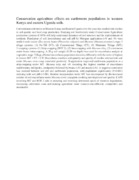| dc.description.abstract | Conventional cultivation in Western Kenya and Eastern Uganda over the years has resulted into decline in soil quality and food crop production. Studying soil biodiversity under Conservation Agriculture production systems (CAPS) will help understand dynamics of soil structure and the replenishment of nutrients. Population of soil invertebrates and soil pH by Nitrogen application (+N and -N) were studied under maize (Zea mays), beans (Phaseolus vulgaris) and Mucuna (Mucuna pruriens) crops: 3 tillage systems; (1) No-Till (NT), (2) Conventional Tilage (CT), (3) Minimum Tillage (MT); 3 cropping systems (1) Strip-cropping (ROT 2), (2) Intercropping with Mucuna riley, (3) continuous maize-beans intercropping. A 20 g soil sample (0-20 cm depth) was used for macrofauna analysis at vegetative stage. Tillage affected macrofauna population densities differently with the order of highest to lowest; MT < NT < CT. Macrofauna numbers and quantity and quality of residue returned into soil under Mucuna cover crop correlated positively. N-application improved earthworm population in a strip-cropping under MT. Mucuna strip and +N recording the highest number of macrofauna (earthworms, millipedes, centipedes) followed by beans (+N) and maize (+N). A negative correlation was realized between soil pH and earthworm population, with population significantly (P<0.001) reducing with soil pH (<5.00). Residue incorporation under MT was decomposed by the increased number of soil macrofauna under Mucuna cover crop plots resulting into improved soil quality. CAPS involving MT and ROT 2 aids in arresting and reversing downward spiral of resource degradation, decreasing cultivation costs and making agriculture more resource-use-efficient, competitive and sustainable. | en_US |

